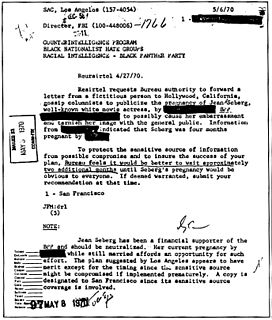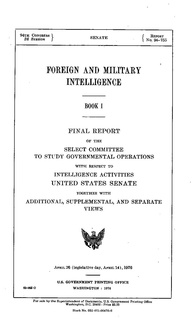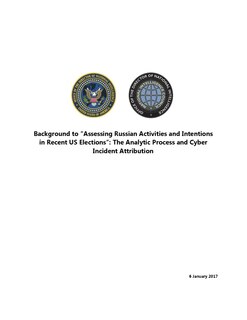Related Research Articles

COINTELPRO (1956–unknown) is a series of covert and illegal projects conducted by the United States Federal Bureau of Investigation (FBI) aimed at surveilling, infiltrating, discrediting, and disrupting domestic American political organizations. FBI records show COINTELPRO resources targeted groups and individuals the FBI deemed subversive, including feminist organizations, the Communist Party USA, anti–Vietnam War organizers, activists of the civil rights movement or Black Power movement, environmentalist and animal rights organizations, the American Indian Movement (AIM), independence movements, and a variety of organizations that were part of the broader New Left and unrelated groups such as the Ku Klux Klan.

The Federal Bureau of Investigation (FBI) is the domestic intelligence and security service of the United States and its principal federal law enforcement agency. Operating under the jurisdiction of the United States Department of Justice, the FBI is also a member of the U.S. Intelligence Community and reports to both the Attorney General and the Director of National Intelligence. A leading U.S. counter-terrorism, counterintelligence, and criminal investigative organization, the FBI has jurisdiction over violations of more than 200 categories of federal crimes.

The Director of Central Intelligence (DCI) was the head of the American Central Intelligence Agency from 1946 to 2005, acting as the principal intelligence advisor to the President of the United States and the United States National Security Council, as well as the coordinator of intelligence activities among and between the various U.S. intelligence agencies.
A special agent is an investigator or detective for a governmental or independent agency, who primarily serves in criminal investigatory positions. Additionally, many federal and state "special agents" operate in "criminal intelligence" based roles as well. Within the U.S. federal law enforcement system, dozens of federal agencies employ federal law enforcement officers, each with different criteria pertaining to the use of the titles Special Agent and Agent.

The United States Senate Select Committee on Intelligence is dedicated to overseeing the United States Intelligence Community—the agencies and bureaus of the federal government of the United States which provide information and analysis for leaders of the executive and legislative branches. The Committee was established in 1976 by the 94th Congress.

The Church Committee was a U.S. Senate select committee in 1975 that investigated abuses by the Central Intelligence Agency (CIA), National Security Agency (NSA), Federal Bureau of Investigation (FBI), and the Internal Revenue Service (IRS). Chaired by Idaho Senator Frank Church (D-ID), the committee was part of a series of investigations into intelligence abuses in 1975, dubbed the "Year of Intelligence", including its House counterpart, the Pike Committee, and the presidential Rockefeller Commission. The committee's efforts led to the establishment of the permanent U.S. Senate Select Committee on Intelligence.
The Huston Plan was a 43-page report and outline of proposed security operations put together by White House aide Tom Charles Huston in 1970. It came to light during the 1973 Watergate hearings headed by Senator Sam Ervin.

Project MINARET was a domestic espionage project operated by the National Security Agency (NSA), which, after intercepting electronic communications that contained the names of predesignated US citizens, passed them to other government law enforcement and intelligence organizations. Intercepted messages were disseminated to the FBI, CIA, Secret Service, Bureau of Narcotics and Dangerous Drugs (BNDD), and the Department of Defense. The project was a sister project to Project SHAMROCK.
Project SHAMROCK, the sister project for Project MINARET, was an espionage exercise started in August 1945, which involved the accumulation of all telegraphic data entering into or exiting from the United States. The Armed Forces Security Agency (AFSA) and its successor, the National Security Agency (NSA), were given direct access to daily microfilm copies of all incoming, outgoing, and transiting telegrams via the Western Union and its associates RCA and ITT. NSA did the operational interception, and, if there was information that would be of interest to other intelligence agencies, the material was passed to them. Intercepted messages were disseminated to the FBI, CIA, Secret Service, Bureau of Narcotics and Dangerous Drugs (BNDD), and the Department of Defense. No court authorized the operation and there were no warrants.
HTLINGUAL, a secret project of the United States of America's Central Intelligence Agency (CIA) to intercept mail destined for the Soviet Union and China, operated from 1952 until 1973. Originally known under the codename SRPOINTER, the project authority was changed in 1955 and renamed. Early on, the CIA collected only the names and addresses appearing on the exterior of mailed items, but they were later opened at CIA facilities in Los Angeles and in New York.

A number of writers have alleged that the United States Central Intelligence Agency (CIA) was involved in the Nicaraguan Contras' cocaine trafficking operations during the 1980s Nicaraguan civil war. These claims have led to investigations by the United States government, including hearings and reports by the United States House of Representatives, Senate, Department of Justice, and the CIA's Office of the Inspector General which ultimately concluded the allegations were unsupported. The subject remains controversial.

The Central Intelligence Agency is a civilian foreign intelligence service of the federal government of the United States, officially tasked with gathering, processing, and analyzing national security information from around the world, primarily through the use of human intelligence (HUMINT). As a principal member of the United States Intelligence Community (IC), the CIA reports to the Director of National Intelligence and is primarily focused on providing intelligence for the President and Cabinet of the United States.

After the Central Intelligence Agency lost its role as the coordinator of the entire Intelligence Community (IC), special coordinating structures were created by each president to fit his administrative style and the perceived level of threat from terrorists during his term.

The Central Intelligence Agency (CIA) is a civilian foreign intelligence service of the United States federal government, tasked with gathering, processing, and analyzing national security information from around the world.

The CIA publishes organizational charts of its agency. Here are a few examples.

The President's Surveillance Program (PSP) is a collection of secret intelligence activities authorized by the President of the United States George W. Bush after the September 11 attacks in 2001 as part of the War on Terrorism. Information collected under this program was protected within a Sensitive Compartmented Information security compartment codenamed STELLARWIND.

The three tramps are three men photographed by several Dallas-area newspapers under police escort near the Texas School Book Depository shortly after the assassination of United States President John F. Kennedy on November 22, 1963. Since the mid-1960s, various allegations have been made about the identities of the men and their involvement in a conspiracy to kill Kennedy.

The practice of mass surveillance in the United States dates back to wartime monitoring and censorship of international communications from, to, or which passed through the United States. After the First and Second World Wars, the surveillance continued throughout the Cold War period, via programs such as the Black Chamber and Project SHAMROCK. The formation and growth of federal law-enforcement and intelligence agencies such as the FBI, CIA, and NSA institutionalized surveillance used to also silence political dissent, as evidenced by COINTELPRO projects which targeted various organizations and individuals. During the Civil Rights Movement era, many individuals put under surveillance orders were first labelled as integrationists then deemed subversive and sometimes suspected to be supportive of the communist model of the United States' rival at the time, the Soviet Union. Other targeted individuals and groups included Native American activists, African American and Chicano liberation movement activists, and anti-war protesters.

The Russian government interfered in the 2016 U.S. presidential election with the goals of harming the campaign of Hillary Clinton, boosting the candidacy of Donald Trump, and increasing political and social discord in the United States. According to U.S. intelligence agencies, the operation was ordered directly by Russian President Vladimir Putin.

Assessing Russian Activities and Intentions in Recent US Elections was a report issued by the United States Office of the Director of National Intelligence that made an assessment of the extent and basis of Russia's interference in United States' elections in 2016. Published on January 6, 2017, the report includes an appraisal by the National Security Agency, the Central Intelligence Agency, and the Federal Bureau of Investigation of the type and breadth of actions undertaken by Russia and affiliated elements during the elections. The report examines Russia's utilization of cyberspace such as hacking and the use of internet trolls and bots, and an intensive media campaign to influence public opinion in the United States. Additionally, it analyzes Russia's intentions and motivations in regards to their influence campaign. Issued in two forms, a classified version and a declassified version, the report drew its conclusions based on highly classified intelligence, an understanding of past Russian actions, and sensitive sources and methods.
References
- ↑ "SUPPLEMENTARY DETAILED STAFF REPORTS ON INTELLIGENCE ACTIVITIES AND THE RIGHTS OF AMERICANS: ... DOMESTIC CIA AND FBI MAIL OPENING PROGRAMS". SELECT COMMITTEE TO STUDY GOVERNMENTAL OPERATIONS WITH RESPECT TO INTELLIGENCE ACTIVITIES UNITED STATES SENATE. April 23, 1976. Retrieved 2009-03-13.
- ↑ Goldstein, Robert. Political Repression in Modern America. University of Illinois Press.
- ↑ Saunders, Frances Stonor. "Stuck on the Flypaper: MI5 and the Hobsbawm File". London Review of Books. 9 April 2015.
- ↑ Nixon, Ron (July 3, 2013). "U.S. Postal Service Logging All Mail for Law Enforcement". New York Times.
| This crime-related article is a stub. You can help Wikipedia by expanding it. |